
Part I looked at how vibration monitoring is able to highlight problems early enough to permit corrective action to be taken at a convenient time, how monitoring can be permanent or periodic, and some of the different measuring and logging systems that are in use. The article continues, looking at the practicalities of making the vibration measurements.
Where and how to monitor
Monitoring should be implemented as close to the bearing as possible - and at right angles to the axis of shaft rotation. This is done by attaching to the desired point with a magnetic clamp or spike. Always attach to the same spot (on the body casting, NOT metal cowling) at each test, and where possible at the same machine speed and loading.
The units of measurement of vibration are laid down in the appropriate standards. The parameter that has been assigned to vibration measurement in the maintenance environment and universally recognised is velocity: mm/sec RMS.
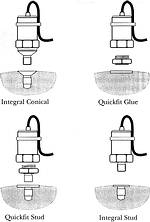
Permanent monitoring
In many industries, because of the nature of the end product, breakdown during production can be catastrophic. Many processes have to be run on a continuous basis, eg, paper and steel mills, newspaper printing presses, extractor fans in hazardous areas, etc. There are many more examples where downtime is measured in thousands of rands per hour. In these areas of maximised production, even a weekly patrol with a data collector could not guarantee continuous running.
In some industries, predictive maintenance has vibration monitoring at the top of the priority list. Likewise, in chemical plants, the savings, thanks to avoiding unpredictable breakdowns, can run into millions of rands over a few years.
More companies build vibration sensors into their end product. It is not a concession to reliability, merely a realistic acceptance of the fact that nothing can run forever.
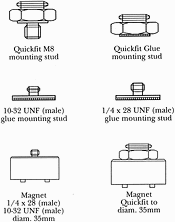
Permanent monitoring - sensor mounting
To allow for extremes of environment, accelerometers usually have their PVC sleeved signal cable encased in an over braided, stainless protective sheath. This offers excellent protection to the cable in industrial conditions, but with long lengths can be difficult to control.
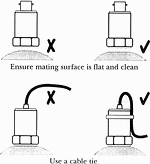
In order to overcome this problem, Temperature Controls recommends the use of a 'Quickfit' adaptor for mechanical fixing of the accelerometer. These simple low-cost devices screw into the standard thread of the sensor, but need less than one turn to mount onto the machine. This eliminates multitwisting of the sensor cable.
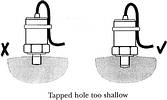
Sensor mounting tips
In order for the accelerometer to faithfully reproduce the vibration generated by the machine under surveillance, it is imperative that its mounting face, in effect, becomes part of the structure. The accelerometer mounting face should see a flat surface at the machine attachment, and not an irregular or curved plane, which will not allow correct transmission of the vibration.
It is also recommended that the sensor cable is looped and then tied with a cable tie to the main body in order to avoid excessive wear.
It is mandatory for machines to have guards fitted wherever there is potential danger to an operator. This can make it difficult to gain access to the running machine in order to correctly undertake the vibration monitoring. A solution is to connect the vibration sensor to the monitoring system via an interconnecting plug/socket, which is attached as shown in Figure 5.
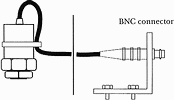
Plant protection systems
An accelerometer is a self-generating device producing an output in the form of a fluctuating electrical charge. In order to be made useable, this signal needs conversion into a voltage signal. This is done by driving the sensor with a constant current source and conditioning its output, which can be achieved in several ways.
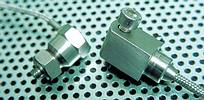
Integral electronics
Accelerometer models are now available which have the necessary circuitry contained within the sensor body. This presents the accelerometer as an industry standard 2-wire 4-20 mA output device, suitable for direct use into PLCs, etc.
Modular protection systems
Specialised modular systems aimed at the maintenance environment are generally housed in a robust wall mounted cabinet, or built into a control panel. Controls are kept to a minimum, but auxiliary outputs (analog and relay) are available for control, data information or alarm functions.
These units can drive accelerometers over a distance of more than 500 m and provide two levels of alarm (amber and red). From the back panel, various outputs are available for each individual channel including 0-10 V dc, 4-20 mA, and 5 A relay changeover contacts. Built-in delays ignore start up transients and individual LED displays allow quick identification of out-of-limit channels. These versatile systems offer online monitoring, retransmission, alarm alerts and further detailed analysis options.
Other monitoring products
Although vibration is perhaps one of the most important parameters in plant monitoring, there are also other techniques that are used.
Proximity sensors, using eddy current techniques, are non-contacting sensors for the measurement of position. These devices are particularly useful in the monitoring of rotating shafts, to give a measurement of misalignment. Misalignment can occur at machine installation or develop as the machine is used over a period of time.
Being non-contacting, the application of the sensor is non-intrusive and can simply be positioned on a support bracket at the correct distance from the rotating shaft. Measurements can be taken in static or dynamic mode and give the maintenance engineer invaluable information on shaft dimensional movement and its speed (by means of a key or hole in the shaft).
For more information contact Andy Brown, Temperature Controls, 011 791 6000, [email protected], www.tempcon.co.za
| Tel: | +27 11 791 6000 |
| Email: | [email protected] |
| www: | www.tempcon.co.za |
| Articles: | More information and articles about Temperature Controls |

© Technews Publishing (Pty) Ltd | All Rights Reserved